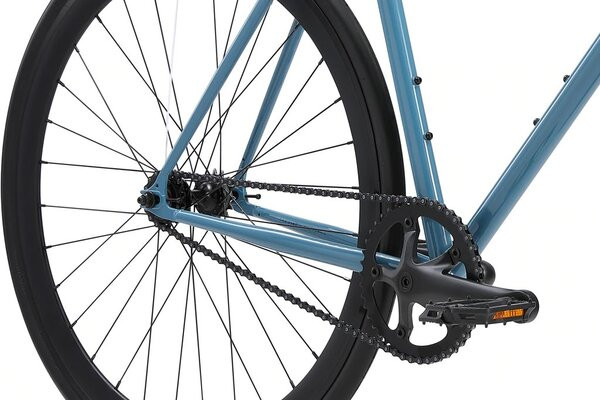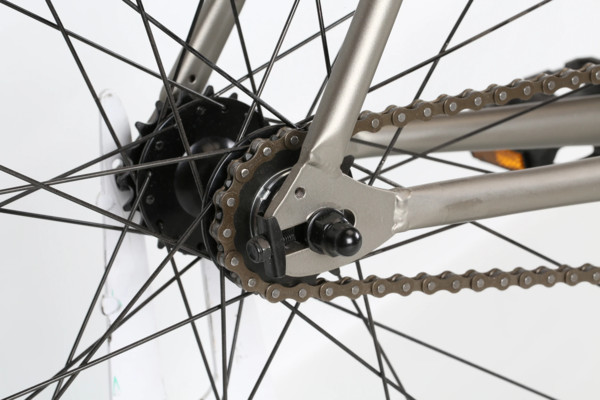
Fixed gear bikes, often called fixies, are known for their simplicity and direct connection between the pedals and wheels. Many Bikes Fixies come equipped with either front and rear brakes, or just a front brake. While riding a fixie without brakes is possible, especially for highly skilled riders in controlled environments, it’s generally not recommended for everyday road use.
While experienced cyclists can slow down a brakeless fixie by backpedaling and skidding, mastering this technique to safely navigate traffic requires considerable skill and practice. Having reliable brakes offers enhanced control and confidence, allowing you to ride more comfortably at higher speeds. Without brakes, you’ll need to anticipate stops far in advance, which can limit your riding style and responsiveness in urban environments.
Fixed Gear Ratio Explained

Choosing the right gear ratio is crucial for any fixie bike, as there is only one gear. This decision depends on your pedaling style (cadence preference), your typical riding terrain (hills or flats), and your fitness level. Some riders prefer a high cadence, “spinning” with an easier gear, while others favor “mashing” – applying more force to a harder gear at a lower cadence.
A common starting point for a versatile gear ratio is 46:16, meaning a 46-tooth chainring paired with a 16-tooth rear cog. Many fixies are sold with this ratio as it provides a good balance for various riding conditions. To calculate the gear ratio, divide the chainring teeth by the cog teeth (e.g., 46 / 16 = 2.875). A higher ratio number indicates a harder gear, requiring more effort to pedal, while a lower number signifies an easier gear.
One advantage of fixies is their efficiency and momentum, which can allow you to comfortably handle a slightly higher gear than you might on a freewheel bike. When selecting your gear ratio, consider finding a balance that allows you to climb hills effectively without losing control on descents. The ideal gear lets you tackle inclines without excessive strain while still providing sufficient resistance for comfortable riding on flat ground.
When purchasing a new fixie, expert advice can be invaluable in choosing the perfect gear ratio for your needs. Test riding different ratios will help you determine what feels right for your fitness, riding style, and typical terrain.
Understanding Fixed Gear Hubs

The rear hub is a specialized component on a fixie bike. Often, fixies utilize a “flip-flop” hub, offering versatility with a fixed gear setup on one side and a freewheel option on the other. This unique hub design features opposing sets of threads on the right side: one for the fixed cog and another for the lockring. The lockring tightens in the opposite direction, securing the cog and preventing it from loosening due to backpedaling forces.
Some advanced hubs include dual sets of these opposing threads or standard freewheel threads on the left side. This design allows for installing different-sized cogs or a single-speed freewheel, offering gear changes or the ability to coast by simply flipping the wheel.
Another key feature of fixie rear hubs is the use of threaded axles and high-quality axle nuts instead of quick-release levers common on geared bikes. This is essential because fixie frames often have horizontal dropouts to adjust chain tension. These dropouts, while allowing chain adjustments, do not lock the rear wheel in a fixed position. Threaded axles and nuts are crucial for maintaining wheel position and preventing slippage under the increased torque and stress inherent in fixed-gear riding.
Choosing Fixed Gear Chains
When it comes to chains for fixies, two primary widths are common: 1/8 inch and 3/32 inch. The wider, heavier 1/8-inch chain is often found on track fixies, BMX bikes, and traditional roadsters due to its robustness. However, 3/32-inch chains are more prevalent overall, as they are the standard type used on multi-speed road and mountain bikes (8, 9, and 10-speed systems). Consequently, they are frequently used on fixies as well.
Using a 3/32-inch chain can be advantageous, particularly when converting an older multi-speed bike to a fixie. It allows you to retain the original crankset. Furthermore, these chains are typically more flexible than 1/8-inch models, resulting in smoother and quieter pedaling. They are also generally lighter in weight, contributing to a slightly more efficient ride.
Selecting Fixie Frames
For converting a frame to fixed-gear use, horizontal dropouts are a necessity. These adjustable dropouts are essential for properly tensioning the chain. Fortunately, many steel road bicycles manufactured 10 to 20 years ago and earlier were equipped with these dropouts.
These older steel frames often possess desirable qualities, being hand-brazed from high-quality steel tubing and featuring attractive lugs. If you can find a vintage road frame or complete bicycle in good condition, it can be an excellent foundation for your fixie project. It’s worth checking that old 10-speed in your garage or shed – it might just be perfect for a fixie conversion!
If you’re unsure whether your bike has suitable dropouts for a fixie conversion, don’t hesitate to Contact Us for guidance.
Fixie Cranks Considerations
When using older 10-speed frames for a fixie build, the original crankset can often be reused. However, you might need to swap the small chainring if it’s not around a 42-tooth size, which is generally considered a good all-around gear. If you have multiple cranksets to choose from, consider one with slightly shorter crankarms than your usual preference. Crankarm length is typically printed on the back of the crankarm, or you can measure from the pedal hole center to the crank bolt hole center. Shorter crankarms can facilitate higher cadences, particularly beneficial on fast downhills.
Choosing Fixie Pedals
Flat pedals are the preferred choice for most fixed gear riders, although some do opt for clipless pedals. Some riders use toe straps with flat pedals to enhance foot retention and control. For those new to fixies, flat pedals are generally recommended as the most accessible starting point.
Customizing Your Fixie Bike
One of the most appealing aspects of fixie bikes is the extensive customization potential. Beyond basic personalization like stickers or spoke cards, you can truly make your fixie unique. Consider options like swapping to flat bars for a different riding posture, adding motorcycle grips for comfort and style, or upgrading to eye-catching disc wheels and color-matched deep-dish rims and hubs.
For a vintage aesthetic, explore incorporating classic bicycle components such as cottered cranks, leather saddles, and ornate quill stems. Let your creativity guide your fixie project and create a bike that truly reflects your personal style. Don’t overlook the impact of a custom paint job – a unique color scheme can make your fixie unmistakably yours.
